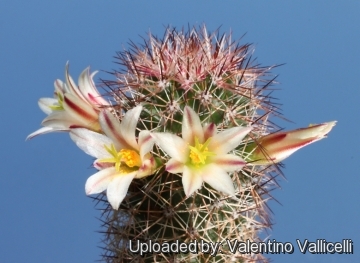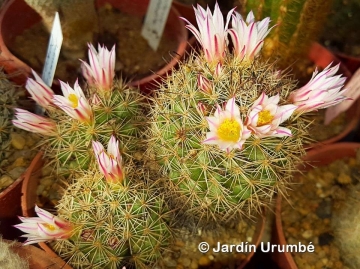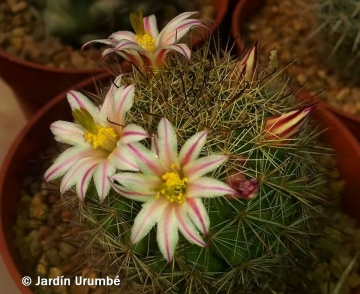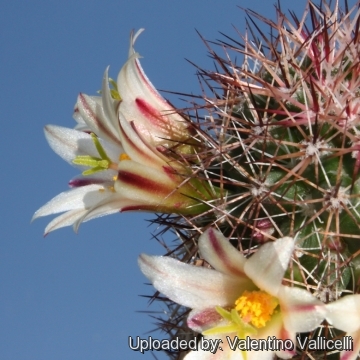Accepted Scientific Name: Mammillaria dioica K.Brandegee
Erythea 5: 115. 1897 as Mamillaria

Chilita dioica (Mammillaria dioica) Photo by: Valentino Vallicelli
Origin and Habitat: Distribution: California (Lower and Upper Sonoran Zones; San Diego County) and Baja California Peninsula and Sonora ( western side of the mountains to Magdalena Bay), Mexico
Altitude: 10-1500 m.
Habitat: Grassy hillsides, gravelly slopes, washes, coastal scrub to creosote-bush scrub and in the Opuntia bigeloviiSN|10929]]SN|10929]] association.
Synonyms:
See all synonyms of Mammillaria dioica
back
Accepted name in llifle Database:Mammillaria dioica K.BrandegeeErythea 5: 115. 1897 as MamillariaSynonymy: 15
back
Common Names include:
ENGLISH: Strawberry Cactus, California Fishhook Cactus, Fishhook cactus, Strawberry pincusion, Coastal Fishhook Cactus, Nipple Cactus
FRENCH (Français): Cactus framboise
SPANISH (Español): Pitayita
UKRAINIAN (Українська): Мамілярія діоїка, Мамілярія дводомна
Description: Mammillaria dioicaSN|916]]SN|916]] is a very spiny cactus often with flowers either all bisexual or all pistillate, a trait unusual for Cactaceae representatives.
Habit: Solitary or with several stems from the base, sometimes branching.
Plant-body: Spheric to long-cylindrical, 4-25 (or occasionally up to 33 cm tall), 3-7 cm in diameter, blue-green, rounded apically, but there is no apical mat of pubescence.
Tubercles: Firm, short cylindrical, without latex.
Axils: Woolly and with 4-15 more or less setose bristles as
long as the tubercles.
Radial spines: 10-22, needle-like, straight, white, or in some the tips rose-colored, purplish, brown or black, 4-10 mm long, spreading
Central spines: 1-4 per areole (sometimes absent), brown to brownish black, needle-like, , stout, 8-15 cm long, the lower one stouter and hooked, upper ones straight, ascending, like the radials,
Flowers: Funnelform yellow to almost white with a pink or purplish midrib, 10-22 mm long, 20-40 cm in diameter, inner perianth-segments, 8 to12, cream to white usually notched at the apex; outer perianth parts entire to minutely fringed; styles white or greenish; stigma-lobes yellowish to green. The flowers usually are imperfectly unisexual, occurring on functionally dioecious plant, but some plants have flowers that are strictly female, with no stamens.
Blooming season: Late winter to late spring.
Fruit: Scarlet, ovoid to clavate, 10-25 mm long, sticking straight out from the stem, sometimes even remaining when a new round of flowers blooms.
Seeds: black, shining, minutely pitted.
Chromosome number: 2n[44]66.
Remarks: The dense covering of spines reduces the interception of solar radiation by the stem surface lowering the risks of overheating the apex during a summer day and of freezing during a winter night.
Subspecies, varieties, forms and cultivars of plants belonging to the Mammillaria dioica group
Bibliography: Major references and further lectures
1) Le Roy Abrams, Roxana Stinchfield Ferris “An Illustrated Flora of the Pacific States: Geraniaceae to Scrophulariaceae, geraniums to figworts” Stanford University Press, 1923
2) E. Yale Dawson “California Natural History Guides” Volume 18 University of California Press, 01/Sep/1966
3) Sia Morhardt, J. Emil Morhardt “California desert flowers: an introduction to families, genera, and species” University of California Press, 2004
4) Arthur Gibson, Park Nobel “The cactus primer” Harvard University Press, 01/Oct/1990
5) Edward Anderson “The Cactus family” Timber Press, Incorporated, 2001
6) James Cullen, Sabina G. Knees, H. Suzanne Cubey "The European Garden Flora Flowering Plants: A Manual for the Identification of Plants Cultivated in Europe, Both Out-of-Doors and Under Glass" Cambridge University Press, 11/Aug/2011
7) David R Hunt; Nigel P Taylor; Graham Charles; International Cactaceae Systematics Group. "The New Cactus Lexicon" dh books, 2006
8) Nathaniel Lord Britton, Joseph Nelson Rose “Cactaceae: Descriptions and Illustrations of Plants of the Cactus Family” Courier Dover Publications, 1963
 Chilita dioica (Mammillaria dioica) Photo by: Valentino Vallicelli
Chilita dioica (Mammillaria dioica) Photo by: Valentino Vallicelli Chilita dioica (Mammillaria dioica) Photo by: Alexander Arzberger
Chilita dioica (Mammillaria dioica) Photo by: Alexander Arzberger Chilita dioica (Mammillaria dioica) Photo by: Alexander Arzberger
Chilita dioica (Mammillaria dioica) Photo by: Alexander Arzberger Chilita dioica (Mammillaria dioica) Photo by: Valentino Vallicelli
Chilita dioica (Mammillaria dioica) Photo by: Valentino Vallicelli Chilita dioica (Mammillaria dioica) Photo by: Valentino Vallicelli
Chilita dioica (Mammillaria dioica) Photo by: Valentino VallicelliSend a photo of this plant.The gallery now contains thousands of pictures, however it is possible to do even more. We are, of course, seeking photos of species not yet shown in the gallery but not only that, we are also looking for better pictures than those already present.
Read More... Cultivation and Propagation: Mammillaria dioicaSN|916]]SN|916]] is somewhat difficult to cultivate. During the summer it is best to keep the plants outside where the temperature can rise to over 30° C with no harm to the plant, recommended for any collection that needs lots of light with ample airflow.
Growth rate: It is a small growing, but easily flowering species. It takes several years to offset, but once it starts it can fill a 25 cm pot in just a few years given the best conditions.
Soils: Use a an open and free draining mineral compost with little organic matter (peat, humus) that allows therefore roots to breath (as it is rot prone).
Repotting: Repotting every 2-3 years. As it is especially prone to rot under-pot in a smaller container filled with very porous compost. Use pot with good drainage.
Watering: It likes a winter's rest and should be kept almost completely dry during the winter months, If the soil is allowed to be dry for too long root loss could follow but equally the same result would occur if the plants are both wet and cold. From March onwards the plant will begin to grow and watering should be increased gradually until late May when the plant should be in full growth. Water regularly during the summer so long as the plant pot is allowed to drain and not sit in a tray of water. During hot weather you may need to water the plants more frequently so long as the plant is actively growing. From late September watering should be reduced to force the plant to go in to a state of semi dormancy, by October you should be back in to the winter watering regime. Keep dry with ample airflow in winter. In the rest period no high atmospheric humidity!! Care must be taken with watering as they tends to become swollen and untidy in growth habit if given too much water and shade.
Fertilization: Feeding may not be necessary at all if the compost is fresh then, feed in summer only if the plant hasn't been repotted recently. Do not feed the plants from September onwards as this can cause lush growth which can be fatal during the darker cold months. .
Hardiness: Grown specimens resist to -4°C for a short time, but it is best to keep above 5° C to avoid ugly spots on the plant epidermis. Some warmth throughout the year will increase the grower's success.
Exposition: Need full sun avoiding only the harshest summer sun, if kept too dark they may become overly lush and greener and could be prone to rotting due to over watering. Tends to bronze in strong light, which encourages flowering and heavy wool and spine production.
Uses: It is an excellent plant for container growing. It always looks good and stays small. It look fine in a cold greenhouse and frame.
Pests & diseases: It may be attractive to a variety of insects, but plants in good condition should be nearly pest-free, particularly if they are grown in a mineral potting-mix, with good exposure and ventilation. Nonetheless, there are several pests to watch for:
- Red spiders: Sensitive to red spider mite. Overhead watering is helpful in controlling mites.
- Mealy bugs: Occasionally mealy bugs they develop aerial into the new growth among the wool with disfiguring results, but the worst types develop underground on the roots and are invisible except by their effects.
- Scales: Scales are rarely a problem.
- Rot: Rot it is only a minor problem with cacti if the plants are watered and “aired” correctly. If they are not, fungicides won't help all that much.
Propagation: Direct sow after last frost. (seldom produces offsets)
Seeds germinate in 7-14 days at 21-27° C in spring, remove the glass cover gradually as the plants develops and keep ventilated, no full sun for young plants! The seedlings should not be disturbed until they are well rooted, after which they can be planted separately in small pots. Cuttings: wait until the offsets that appear at the base of old clustered specimens are 1/3 the size of the parent and then detach and plant. Cuttings will take root in a minimum temperature of 20° C (but better in hot weather). Cuttings of healthy shoots can be taken in the spring and summer. Cut the stem with a sharp, sterile knife, leave the cutting in a warm, dry place for a week or weeks (depending on how thick the cutting is) until a callus forms over the wound. Once the callus forms, the cutting may be inserted in a container filled with firmed cactus potting mix topped with a surface layer of coarse grit. They should be placed in the coarse grit only; this prevents the cut end from becoming too wet and allows the roots to penetrate the rich compost underneath. The cuttings should root in 2 to 6 weeks.















